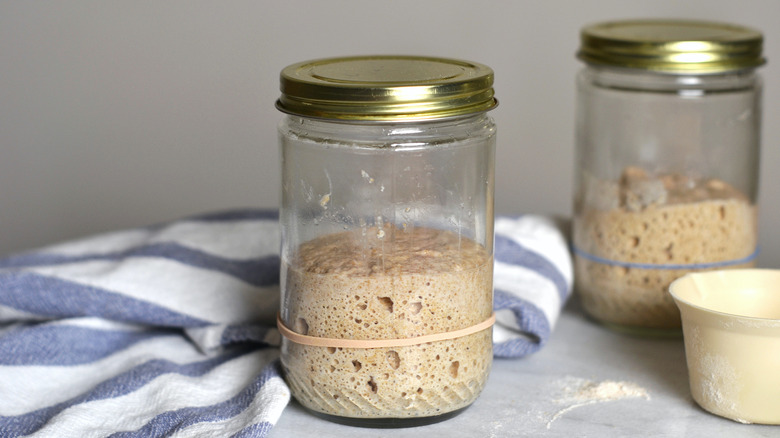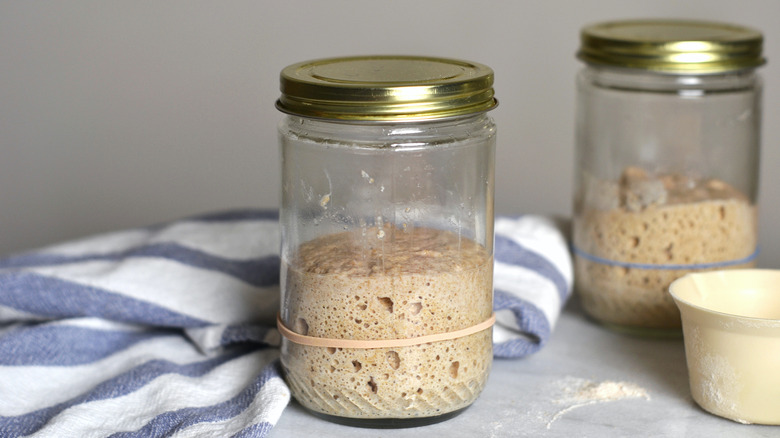Foolproof Sourdough Starter Recipe
Making sourdough bread was all the rage during the pandemic when social distancing left many with time on their hands, but the trend seemed to die off when the world resumed again. One reason why many people may have abandoned their sourdough starter could have been the fact that it can be kind of a pain to maintain. With this foolproof starter, however, recipe developer Rika Hoffman demystifies the process for you with step-by-step, day-by-day instructions. They tell us, "This recipe is for a 100% hydration sourdough starter, meaning that it is fed using equal weights of flour and water."
Hoffman recommends using a kitchen scale to measure the flour in order to ensure accuracy but admits that this is not really necessary since you can use cup and tablespoon measures if you prefer. They also say that different flour types can be used depending on your preference.
Collect the ingredients for foolproof sourdough starter
The main ingredients in this sourdough starter are simply flour and water, nothing more. Hoffman does recommend using filtered or spring water, though. They say, "Tap water may contain chlorine which inhibits yeast growth."
Hoffman also notes that this recipe does contain a secret, albeit optional, ingredient: pineapple or orange juice. They note that the acid lowers the pH, which gives more predictable results by controlling the growth of certain bacteria.
Make the starter and let it sit
The first step in making this sourdough starter is to sterilize a glass jar to make sure no rogue bacteria invade. As Hoffman explains, "I rinse my [jars] in just-boiled water and let them cool before using."
Now measure ½ cup of flour (this would be about 63 grams if you want to weigh it) into the jar along with ½ cup of water or juice (about 118 grams), then stir these ingredients together until all of the flour has been mixed into the liquid and no dry clumps remain. Use a rubber spatula to scrape down the sides of the jar, then put a rubber band around it right where the flour/water mixture hits. Hoffman says, "This will make it easy to see when the starter has increased in volume."
Put a lid on the jar, then let the starter sit out at room temperature for 48 hours. Twice a day, once in the morning and again at night, open the jar and stir the starter, then close the lid again. Hoffman notes that on the first day the starter may not appear to be doing much of anything, but says, "By the end of the first 48 hours, the starter's volume may increase as bubbles start to form."
Feed the starter after 48 hours
After 48 hours is up, no matter what the starter is or isn't doing, it's time to begin the process called "feeding." This isn't as simple as just adding flour and water to the pre-existing starter. Instead, you'll need a clean jar. Measure 3 tablespoons (approximately 42 grams) of the old starter mixture into the new jar, then toss out the rest of the previous day's starter. Stir 5¼ tablespoons (42 grams) of flour and 3 tablespoons (42 grams) of water into the starter in the new jar, then cover it and let it sit for 24 to 48 hours. Again, you'll be stirring the starter morning and night in order to aerate it.
Continue the daily feedings until the starter is finished
Once the starter starts to bubble, or it's been sitting for 48 hours with no activity, again take a clean jar and use it to mix 3 tablespoons of the old starter with another 5½ tablespoons of flour and 3 tablespoons water. Again cover the jar and let the starter sit for 24 hours or until It doubles in volume, whichever comes first. Be sure to stir it twice a day as before.
Repeat the whole feeding process every 24 hours until the starter is regularly doubling its volume within 12 hours of feeding. At this point, it's considered to be strong enough to bake with. This whole process could take just 7 days from when you first began the starter, or it could take 14 days or even longer depending on the type of flour you use, the weather, and how often you stir it. Hoffman does have some advice if the starter is really sluggish, though, recommending, "If there is little to no activity, stir 2 to 3 times daily and allow for more time between feedings."

- 4¼ cups + ¾ teaspoon (609 grams) all-purpose, bread, whole wheat, rye, or spelt flour, divided
- Water (spring or filtered is recommended)
- ½ cup (118 grams) pineapple or orange juice
- Combine ½ cup (63 grams) of flour with ½ cup (118 grams) of water or juice in a clean jar and mix these ingredients until all of the flour is moistened.
- Scrape down the sides of the jar with a spatula and place a rubber band around it to indicate the starting volume of the sourdough starter.
- Cover the jar and let it sit at room temperature for 48 hours, stirring twice a day in the morning and evening.
- After 48 hours have passed, use a clean jar to mix 5¼ tablespoons (42 grams) of flour and 3 tablespoons (42 grams) of water with 3 tablespoons (approximately 42 grams) of the starter mixture, then discard the remaining original starter mixture.
- Let the starter sit for 24 to 48 hours, stirring it twice a day to aerate it.
- After the sourdough starter starts to look bubbly or 48 hours have passed, repeat the process of mixing 3 tablespoons starter, 5½ tablespoons flour, and 3 tablespoons water and discarding the previous day's starter.
- Stir the starter twice daily and let it sit until it has doubled in volume or 24 hours have passed, whichever comes first.
- Repeat the process of mixing 3 tablespoons starter, 5½ tablespoons flour, and 3 tablespoons water and discarding the previous day's starter on a daily basis until the starter is consistently doubling in volume within 12 hours of feeding. This should take between 7 and 14 days from when you began the starter, but may take longer depending on environmental factors and the type of flour used.
- Use the finished starter to bake sourdough bread.




